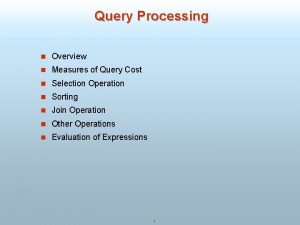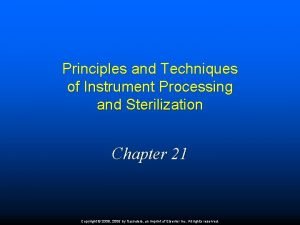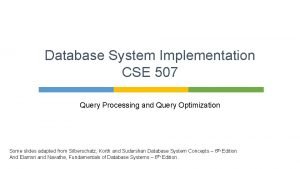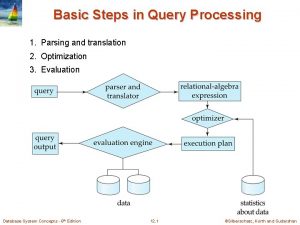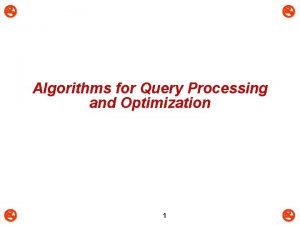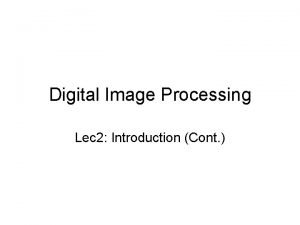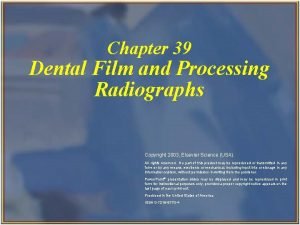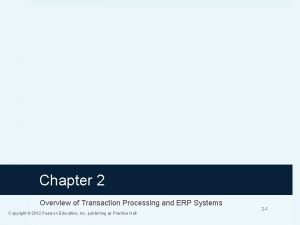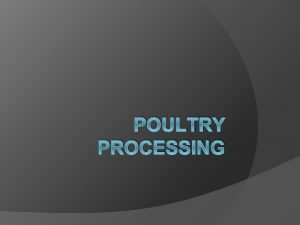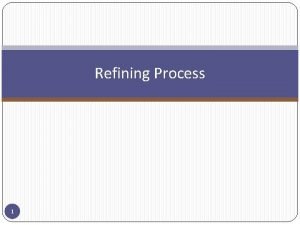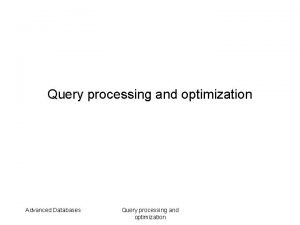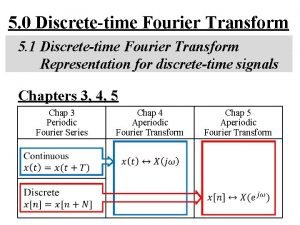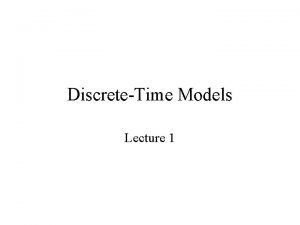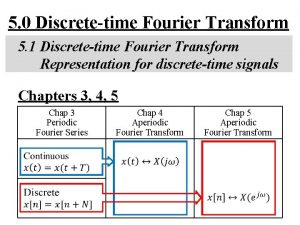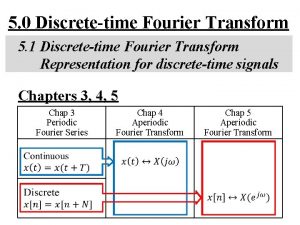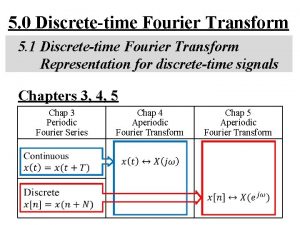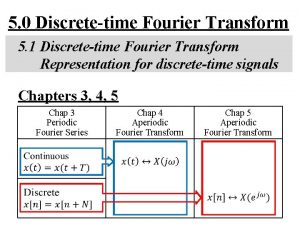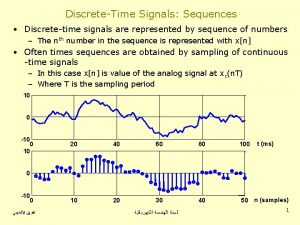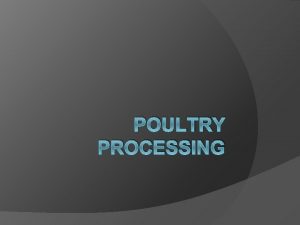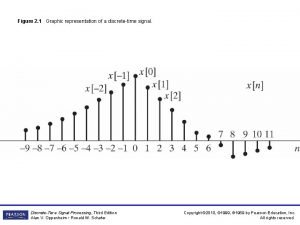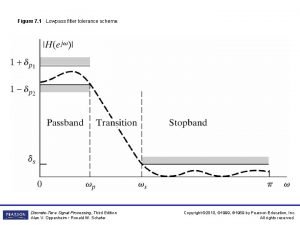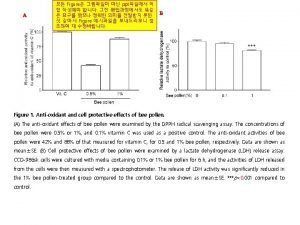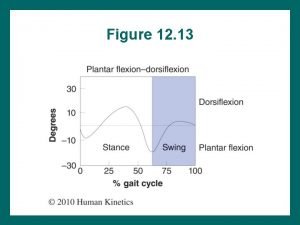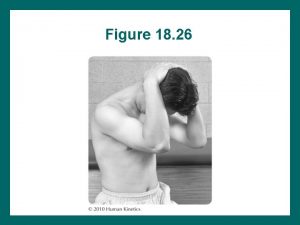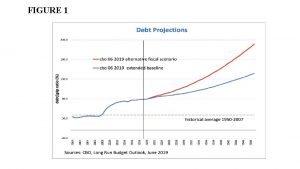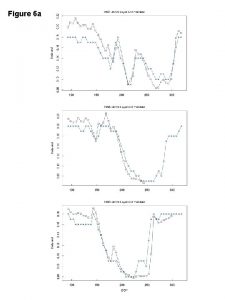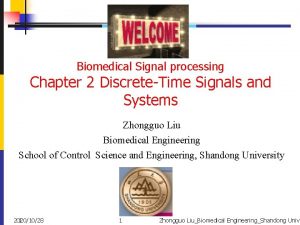Figure 10 1 Processing steps in the discretetime













![Figure 10. 11 Two segments of the linear chirp signal x[n] = cos(α 0 Figure 10. 11 Two segments of the linear chirp signal x[n] = cos(α 0](https://slidetodoc.com/presentation_image/6a5da5c32d3d4f119296b836f7f25624/image-14.jpg)

![Figure 10. 13 The magnitude of the time-dependent Fourier transform of y[n] in Eq. Figure 10. 13 The magnitude of the time-dependent Fourier transform of y[n] in Eq.](https://slidetodoc.com/presentation_image/6a5da5c32d3d4f119296b836f7f25624/image-16.jpg)
















![Figure 10. 28 Computation of the circular autocorrelation. (a) x[n] and x[n + m] Figure 10. 28 Computation of the circular autocorrelation. (a) x[n] and x[n + m]](https://slidetodoc.com/presentation_image/6a5da5c32d3d4f119296b836f7f25624/image-33.jpg)






























- Slides: 63

Figure 10. 1 Processing steps in the discrete-time Fourier analysis of a continuous-time signal. Discrete-Time Signal Processing, Third Edition Alan V. Oppenheim • Ronald W. Schafer Copyright © 2010, © 1999, © 1989 by Pearson Education, Inc. All rights reserved.

Figure 10. 2 Illustration of the Fourier transforms of the system of Figure 10. 1. (a) Fourier transform of continuous-time input signal. (b) Frequency response of antialiasing filter. (c) Fourier transform of output of antialiasing filter. (d) Fourier transform of sampled signal. (e) Fourier transform of window sequence. (f) Fourier transform of windowed signal segment and frequency samples obtained using DFT samples. Discrete-Time Signal Processing, Third Edition Alan V. Oppenheim • Ronald W. Schafer Copyright © 2010, © 1999, © 1989 by Pearson Education, Inc. All rights reserved.

Figure 10. 3 Illustration of Fourier analysis of windowed cosines with a rectangular window. (a) Fourier transform of window. (b)–(e) Fourier transform of windowed cosines as Ω 1 − Ω 0 becomes progressively smaller. (b) Ω 0 = (2π/6) × 104, Ω 1 = (2π/3) × 104. Discrete-Time Signal Processing, Third Edition Alan V. Oppenheim • Ronald W. Schafer Copyright © 2010, © 1999, © 1989 by Pearson Education, Inc. All rights reserved.

Figure 10. 3 (continued) Illustration of Fourier analysis of windowed cosines with a rectangular window. (c) Ω 0 = (2π/14) × 104, Ω 1 = (4π/15) × 104. (d) Ω 0 = (2π/14) × 104, Ω 1 = (2π/12) × 104. (e) Ω 0 = (2π/14) × 104, Ω 1 = (4π/25) × 104. Discrete-Time Signal Processing, Third Edition Alan V. Oppenheim • Ronald W. Schafer Copyright © 2010, © 1999, © 1989 by Pearson Education, Inc. All rights reserved.

Figure 10. 4 (a) Kaiser windows for β = 0, 3, and 6 and L = 21. (b) Fourier transform corresponding to windows in (a). (c) Fourier transforms of Kaiser windows with β = 6 and L = 11, 21, and 41. Discrete-Time Signal Processing, Third Edition Alan V. Oppenheim • Ronald W. Schafer Copyright © 2010, © 1999, © 1989 by Pearson Education, Inc. All rights reserved.

Figure 10. 5 Cosine sequence and DFT with a rectangular window for N = 64. (a) Windowed signal. (b) Real part of DFT. (c) Imaginary part of DFT. Note that the DTFT is superimposed as the light continuous line. Discrete-Time Signal Processing, Third Edition Alan V. Oppenheim • Ronald W. Schafer Copyright © 2010, © 1999, © 1989 by Pearson Education, Inc. All rights reserved.

Figure 10. 5 (continued) Cosine sequence and DFT with a rectangular window for N = 64. (d) Magnitude of DFT. (e) Phase of DFT. Discrete-Time Signal Processing, Third Edition Alan V. Oppenheim • Ronald W. Schafer Copyright © 2010, © 1999, © 1989 by Pearson Education, Inc. All rights reserved.

Figure 10. 6 Discrete Fourier analysis of the sum of two sinusoids for a case in which the Fourier transform is zero at all DFT frequencies except those corresponding to the frequencies of the two sinusoidal components. (a) Windowed signal. (b) Magnitude of DFT. Note that (|V(ejω)|) is superimposed as the light continuous line. Discrete-Time Signal Processing, Third Edition Alan V. Oppenheim • Ronald W. Schafer Copyright © 2010, © 1999, © 1989 by Pearson Education, Inc. All rights reserved.

Figure 10. 7 DFT of the signal as in Figure 10. 6(a), but with twice the number of frequency samples used in Figure 10. 6(b). Discrete-Time Signal Processing, Third Edition Alan V. Oppenheim • Ronald W. Schafer Copyright © 2010, © 1999, © 1989 by Pearson Education, Inc. All rights reserved.

Figure 10. 8 Discrete Fourier analysis with Kaiser window. (a) Windowed sequence for L = 64. (b) Magnitude of DFT for L = 64. (c) Windowed sequence for L = 32. (d) Magnitude of DFT for L = 32. Discrete-Time Signal Processing, Third Edition Alan V. Oppenheim • Ronald W. Schafer Copyright © 2010, © 1999, © 1989 by Pearson Education, Inc. All rights reserved.

Figure 10. 9 Illustration of effect of DFT length for Kaiser window of length L = 32. (a) Magnitude of DFT for N = 32. Discrete-Time Signal Processing, Third Edition Alan V. Oppenheim • Ronald W. Schafer Copyright © 2010, © 1999, © 1989 by Pearson Education, Inc. All rights reserved.

Figure 10. 9 (continued) Illustration of effect of DFT length for Kaiser window of length L = 32. (b) Magnitude of DFT for N = 64. (c) Magnitude of DFT for N = 128. Discrete-Time Signal Processing, Third Edition Alan V. Oppenheim • Ronald W. Schafer Copyright © 2010, © 1999, © 1989 by Pearson Education, Inc. All rights reserved.

Figure 10. 10 Illustration of the computation of the DFT for N » L with linear interpolation to create a smooth curve: (a) N = 1024, L = 32. (b) N = 1024, L = 42. (c) N = 1024, L = 64. (The values k 0 = 146 ≈ 2048/14 and k 1 = 273 ≈ 4096/15 are the closest DFT frequencies to ω0 = 2π/14 and ω1 = 4π/15 when the DFT length is N = 2048. ) Discrete-Time Signal Processing, Third Edition Alan V. Oppenheim • Ronald W. Schafer Copyright © 2010, © 1999, © 1989 by Pearson Education, Inc. All rights reserved.
![Figure 10 11 Two segments of the linear chirp signal xn cosα 0 Figure 10. 11 Two segments of the linear chirp signal x[n] = cos(α 0](https://slidetodoc.com/presentation_image/6a5da5c32d3d4f119296b836f7f25624/image-14.jpg)
Figure 10. 11 Two segments of the linear chirp signal x[n] = cos(α 0 n 2) for α 0 = 15π× 10− 6 with a 400 -sample Hamming window superimposed. (a) X[n, λ) at n = 320 would be the DTFT of the top trace multiplied by the window. (b) X[720, λ) would be the DTFT of the bottom trace multiplied by the window. Discrete-Time Signal Processing, Third Edition Alan V. Oppenheim • Ronald W. Schafer Copyright © 2010, © 1999, © 1989 by Pearson Education, Inc. All rights reserved.

Figure 10. 12 DTFTs of segments of a linear chirp signal: (a) DTFT of 20, 000 samples of the signal x [n] = cos(α 0 n 2). (b) DTFT of x [5000 + m]w[m] where w[m] is a Hamming window of length L = 401; i. e. , X[5000, λ). (c) DTFT of x[15, 000 + m]w[m] where w[m] is a Hamming window of length L = 401; i. e. , X[15, 000, λ). Discrete-Time Signal Processing, Third Edition Alan V. Oppenheim • Ronald W. Schafer Copyright © 2010, © 1999, © 1989 by Pearson Education, Inc. All rights reserved.
![Figure 10 13 The magnitude of the timedependent Fourier transform of yn in Eq Figure 10. 13 The magnitude of the time-dependent Fourier transform of y[n] in Eq.](https://slidetodoc.com/presentation_image/6a5da5c32d3d4f119296b836f7f25624/image-16.jpg)
Figure 10. 13 The magnitude of the time-dependent Fourier transform of y[n] in Eq. (10. 23): (a) Using a Hamming window of length L = 401. (b) Using a Hamming window of length L = 101. Discrete-Time Signal Processing, Third Edition Alan V. Oppenheim • Ronald W. Schafer Copyright © 2010, © 1999, © 1989 by Pearson Education, Inc. All rights reserved.

Figure 10. 14 (a) Illustration of the Fourier transform of a Bartlett window for time-dependent Fourier analysis. (b) Equivalent bandpass filter for time-dependent Fourier analysis. Discrete-Time Signal Processing, Third Edition Alan V. Oppenheim • Ronald W. Schafer Copyright © 2010, © 1999, © 1989 by Pearson Education, Inc. All rights reserved.

Figure 10. 15 Filter bank representation of the time-dependent Fourier transform. Discrete-Time Signal Processing, Third Edition Alan V. Oppenheim • Ronald W. Schafer Copyright © 2010, © 1999, © 1989 by Pearson Education, Inc. All rights reserved.

Figure 10. 16 (a) Region of support for X[n, λ). (b) Grid of sampling points in the [n, λ)-plane for the sampled timedependent Fourier transform with N = 10 and R = 3. Discrete-Time Signal Processing, Third Edition Alan V. Oppenheim • Ronald W. Schafer Copyright © 2010, © 1999, © 1989 by Pearson Education, Inc. All rights reserved.

Figure 10. 17 (a) Shifted M + 1 -point Bartlett windows with R = M/2. (b) Shifted M + 1 -point Hann windows with R = M/2. The dashed line is the periodic sequence w[n]. Discrete-Time Signal Processing, Third Edition Alan V. Oppenheim • Ronald W. Schafer Copyright © 2010, © 1999, © 1989 by Pearson Education, Inc. All rights reserved.

Figure 10. 18 Signal processing based on time-dependent Fourier analysis/ synthesis. Discrete-Time Signal Processing, Third Edition Alan V. Oppenheim • Ronald W. Schafer Copyright © 2010, © 1999, © 1989 by Pearson Education, Inc. All rights reserved.

Figure 10. 19 Filterbank frequency response. (a) Rectangular window. (b) Kaiser window. Discrete-Time Signal Processing, Third Edition Alan V. Oppenheim • Ronald W. Schafer Copyright © 2010, © 1999, © 1989 by Pearson Education, Inc. All rights reserved.

Figure 10. 20 Several bandpass channels for the MPEG-II analysis filter bank. Discrete-Time Signal Processing, Third Edition Alan V. Oppenheim • Ronald W. Schafer Copyright © 2010, © 1999, © 1989 by Pearson Education, Inc. All rights reserved.

Figure 10. 21 Waveform of the speech utterance “Two plus seven is less than ten. ” Each line is 0. 17 s in duration. The time-aligned phonemic transcript is indicated below the waveform. The sampling rate is 16, 000 samples/s, so each line represents 2720 samples. Discrete-Time Signal Processing, Third Edition Alan V. Oppenheim • Ronald W. Schafer Copyright © 2010, © 1999, © 1989 by Pearson Education, Inc. All rights reserved.

Figure 10. 22 (a) Wideband spectrogram of waveform of Figure 10. 21. (b) Narrowband spectrogram. Discrete-Time Signal Processing, Third Edition Alan V. Oppenheim • Ronald W. Schafer Copyright © 2010, © 1999, © 1989 by Pearson Education, Inc. All rights reserved.

Figure 10. 23 Illustration of time-dependent Fourier analysis of Doppler radar signal. (a) Sequence of Fourier transforms of Doppler radar signal. (b) Doppler frequency estimated by picking the largest peak in the time-dependent Fourier transform. Discrete-Time Signal Processing, Third Edition Alan V. Oppenheim • Ronald W. Schafer Copyright © 2010, © 1999, © 1989 by Pearson Education, Inc. All rights reserved.

Figure 10. 24 Periodograms of pseudorandom white-noise sequence. (a) Window length L = 16 and DFT length N = 1024. Discrete-Time Signal Processing, Third Edition Alan V. Oppenheim • Ronald W. Schafer Copyright © 2010, © 1999, © 1989 by Pearson Education, Inc. All rights reserved.

Figure 10. 24 (continued) Periodograms of pseudorandom white-noise sequence. (b) L = 64 and N = 1024. (c) L = 256 and N = 1024. (d) L = 1024 and N = 1024. Discrete-Time Signal Processing, Third Edition Alan V. Oppenheim • Ronald W. Schafer Copyright © 2010, © 1999, © 1989 by Pearson Education, Inc. All rights reserved.

Figure 10. 25 Illustration of sequences involved in Eq. (10. 69). (a) A finite-length sequence. (b) Shifted sequence for m > 0. Discrete-Time Signal Processing, Third Edition Alan V. Oppenheim • Ronald W. Schafer Copyright © 2010, © 1999, © 1989 by Pearson Education, Inc. All rights reserved.

Figure 10. 26 Cosine sequence with white noise, as in Eq. (10. 93). Discrete-Time Signal Processing, Third Edition Alan V. Oppenheim • Ronald W. Schafer Copyright © 2010, © 1999, © 1989 by Pearson Education, Inc. All rights reserved.

Figure 10. 27 Example of average periodogram for signal of length Q = 1024. (a) Periodogram for window length L = Q = 1024 (only one segment). (b) K = 7 and L = 256 (overlap by L/2). (c) K = 31 and L = 64. Discrete-Time Signal Processing, Third Edition Alan V. Oppenheim • Ronald W. Schafer Copyright © 2010, © 1999, © 1989 by Pearson Education, Inc. All rights reserved.

Figure 10. 27 (continued) Example of average periodogram for signal of length Q = 1024. (d) K = 127 and L = 16. Discrete-Time Signal Processing, Third Edition Alan V. Oppenheim • Ronald W. Schafer Copyright © 2010, © 1999, © 1989 by Pearson Education, Inc. All rights reserved.
![Figure 10 28 Computation of the circular autocorrelation a xn and xn m Figure 10. 28 Computation of the circular autocorrelation. (a) x[n] and x[n + m]](https://slidetodoc.com/presentation_image/6a5da5c32d3d4f119296b836f7f25624/image-33.jpg)
Figure 10. 28 Computation of the circular autocorrelation. (a) x[n] and x[n + m] for a finite-length sequence of length Q. (b) x [n] and x [((n + m))N ] as in circular correlation. Discrete-Time Signal Processing, Third Edition Alan V. Oppenheim • Ronald W. Schafer Copyright © 2010, © 1999, © 1989 by Pearson Education, Inc. All rights reserved.

Figure 10. 29 Procedure for obtaining quantization noise sequence. Discrete-Time Signal Processing, Third Edition Alan V. Oppenheim • Ronald W. Schafer Copyright © 2010, © 1999, © 1989 by Pearson Education, Inc. All rights reserved.

Figure 10. 30 Speech waveform (first and third lines) and the corresponding quantization error (second and fourth lines) for 10 -bit quantization (magnified 29 times). Each line corresponds to 1000 consecutive samples connected by straight lines for convenience in plotting. Discrete-Time Signal Processing, Third Edition Alan V. Oppenheim • Ronald W. Schafer Copyright © 2010, © 1999, © 1989 by Pearson Education, Inc. All rights reserved.

Figure 10. 31 (a) Autocorrelation estimate for 10 -bit quantization noise for |m| ≤ 100 with record length Q = 3, 000. (b) Power spectrum estimates by the Blackman–Tukey method using Bartlett windows with M = 100 and M = 50. (Dashed line shows level of 10 log 10(2− 18/12). ) Discrete-Time Signal Processing, Third Edition Alan V. Oppenheim • Ronald W. Schafer Copyright © 2010, © 1999, © 1989 by Pearson Education, Inc. All rights reserved.

Figure 10. 32 (a) Autocorrelation estimate for 10 -bit quantization noise; record length Q = 30, 000. (b) Power spectrum estimates by the Blackman–Tukey method using Bartlett windows with M = 100 and M = 50. Discrete-Time Signal Processing, Third Edition Alan V. Oppenheim • Ronald W. Schafer Copyright © 2010, © 1999, © 1989 by Pearson Education, Inc. All rights reserved.

Figure 10. 33 Speech waveform (first and third lines) and the corresponding quantization error (second and fourth lines) for 4 -bit quantization (magnified 23 times). Each line corresponds to 1000 consecutive samples connected by straight lines for convenience in plotting. Discrete-Time Signal Processing, Third Edition Alan V. Oppenheim • Ronald W. Schafer Copyright © 2010, © 1999, © 1989 by Pearson Education, Inc. All rights reserved.

Figure 10. 34 (a) Autocorrelation estimate for 4 -bit quantization noise; record length Q = 30, 000. (b) Power spectrum estimates by the Blackman–Tukey method using Bartlett windows with M = 100 and M = 50. (Dashed line shows level of 10 log 10(2− 6/12). ) Discrete-Time Signal Processing, Third Edition Alan V. Oppenheim • Ronald W. Schafer Copyright © 2010, © 1999, © 1989 by Pearson Education, Inc. All rights reserved.

Figure 10. 35 (a) Autocorrelation estimate for speech signal of Figure 10. 21; record length Q = 30, 000. (b) Power spectrum estimates by the Blackman–Tukey method using Bartlett window (heavy line) and Hamming window (light line) with M = 50. Discrete-Time Signal Processing, Third Edition Alan V. Oppenheim • Ronald W. Schafer Copyright © 2010, © 1999, © 1989 by Pearson Education, Inc. All rights reserved.

Figure 10. 36 Power spectrum estimates by the Blackman–Tukey method using Bartlett window (heavy line) and Hamming window (light line) with M = 50. The dashed line shows the power spectrum obtained by averaging overlapping periodograms using a Hamming window with M = 50. Discrete-Time Signal Processing, Third Edition Alan V. Oppenheim • Ronald W. Schafer Copyright © 2010, © 1999, © 1989 by Pearson Education, Inc. All rights reserved.

Figure P 10. 10 Discrete-Time Signal Processing, Third Edition Alan V. Oppenheim • Ronald W. Schafer Copyright © 2010, © 1999, © 1989 by Pearson Education, Inc. All rights reserved.

Figure P 10. 18 Discrete-Time Signal Processing, Third Edition Alan V. Oppenheim • Ronald W. Schafer Copyright © 2010, © 1999, © 1989 by Pearson Education, Inc. All rights reserved.

Figure P 10. 24 -1 Discrete-Time Signal Processing, Third Edition Alan V. Oppenheim • Ronald W. Schafer Copyright © 2010, © 1999, © 1989 by Pearson Education, Inc. All rights reserved.

Figure P 10. 24 -2 Discrete-Time Signal Processing, Third Edition Alan V. Oppenheim • Ronald W. Schafer Copyright © 2010, © 1999, © 1989 by Pearson Education, Inc. All rights reserved.

Figure P 10. 24 -3 Discrete-Time Signal Processing, Third Edition Alan V. Oppenheim • Ronald W. Schafer Copyright © 2010, © 1999, © 1989 by Pearson Education, Inc. All rights reserved.

Figure P 10. 25 Filter bank Discrete-Time Signal Processing, Third Edition Alan V. Oppenheim • Ronald W. Schafer Copyright © 2010, © 1999, © 1989 by Pearson Education, Inc. All rights reserved.

Figure 10. 26 -1 Discrete-Time Signal Processing, Third Edition Alan V. Oppenheim • Ronald W. Schafer Copyright © 2010, © 1999, © 1989 by Pearson Education, Inc. All rights reserved.

Figure P 10. 26 -2 Discrete-Time Signal Processing, Third Edition Alan V. Oppenheim • Ronald W. Schafer Copyright © 2010, © 1999, © 1989 by Pearson Education, Inc. All rights reserved.

Figure P 10. 26 -3 Discrete-Time Signal Processing, Third Edition Alan V. Oppenheim • Ronald W. Schafer Copyright © 2010, © 1999, © 1989 by Pearson Education, Inc. All rights reserved.

Figure P 10. 26 -4 Discrete-Time Signal Processing, Third Edition Alan V. Oppenheim • Ronald W. Schafer Copyright © 2010, © 1999, © 1989 by Pearson Education, Inc. All rights reserved.

Figure P 10. 27 Discrete-Time Signal Processing, Third Edition Alan V. Oppenheim • Ronald W. Schafer Copyright © 2010, © 1999, © 1989 by Pearson Education, Inc. All rights reserved.

Figure P 10. 28 -1 Discrete-Time Signal Processing, Third Edition Alan V. Oppenheim • Ronald W. Schafer Copyright © 2010, © 1999, © 1989 by Pearson Education, Inc. All rights reserved.

Figure P 10. 28 -2 Discrete-Time Signal Processing, Third Edition Alan V. Oppenheim • Ronald W. Schafer Copyright © 2010, © 1999, © 1989 by Pearson Education, Inc. All rights reserved.

Figure P 10. 29 Discrete-Time Signal Processing, Third Edition Alan V. Oppenheim • Ronald W. Schafer Copyright © 2010, © 1999, © 1989 by Pearson Education, Inc. All rights reserved.

Figure P 10. 32 Discrete-Time Signal Processing, Third Edition Alan V. Oppenheim • Ronald W. Schafer Copyright © 2010, © 1999, © 1989 by Pearson Education, Inc. All rights reserved.

Figure P 10. 46 -1 Discrete-Time Signal Processing, Third Edition Alan V. Oppenheim • Ronald W. Schafer Copyright © 2010, © 1999, © 1989 by Pearson Education, Inc. All rights reserved.

Figure P 10. 46 -2 Discrete-Time Signal Processing, Third Edition Alan V. Oppenheim • Ronald W. Schafer Copyright © 2010, © 1999, © 1989 by Pearson Education, Inc. All rights reserved.

Figure P 10. 46 -3 Discrete-Time Signal Processing, Third Edition Alan V. Oppenheim • Ronald W. Schafer Copyright © 2010, © 1999, © 1989 by Pearson Education, Inc. All rights reserved.

Figure P 10. 48 Discrete-Time Signal Processing, Third Edition Alan V. Oppenheim • Ronald W. Schafer Copyright © 2010, © 1999, © 1989 by Pearson Education, Inc. All rights reserved.

Figure P 10. 50 -1 Discrete-Time Signal Processing, Third Edition Alan V. Oppenheim • Ronald W. Schafer Copyright © 2010, © 1999, © 1989 by Pearson Education, Inc. All rights reserved.

Figure P 10. 50 -2 Discrete-Time Signal Processing, Third Edition Alan V. Oppenheim • Ronald W. Schafer Copyright © 2010, © 1999, © 1989 by Pearson Education, Inc. All rights reserved.

Figure P 10. 50 -3 Discrete-Time Signal Processing, Third Edition Alan V. Oppenheim • Ronald W. Schafer Copyright © 2010, © 1999, © 1989 by Pearson Education, Inc. All rights reserved.
 Top-down processing vs bottom-up processing
Top-down processing vs bottom-up processing Gloria suarez
Gloria suarez Bottom up processing example
Bottom up processing example Point processing and neighbourhood processing
Point processing and neighbourhood processing Example of primary processing
Example of primary processing What is point processing in digital image processing
What is point processing in digital image processing Histogram processing in digital image processing
Histogram processing in digital image processing Parallel processing vs concurrent processing
Parallel processing vs concurrent processing Neighborhood processing in digital image processing
Neighborhood processing in digital image processing پردازش تصویر
پردازش تصویر Morphological processing in digital image processing
Morphological processing in digital image processing Top down vs bottom up psychology
Top down vs bottom up psychology Batch processing vs interactive processing
Batch processing vs interactive processing Zooming and shrinking in digital image processing
Zooming and shrinking in digital image processing Steps in query processing
Steps in query processing Methods of instrument processing
Methods of instrument processing Tissue processing steps
Tissue processing steps Steps in query processing
Steps in query processing Stages of tissue processing
Stages of tissue processing Steps of query processing
Steps of query processing Steps in query processing
Steps in query processing Text processing steps
Text processing steps Steps of query processing
Steps of query processing Steps in query processing
Steps in query processing Manual film processing steps
Manual film processing steps Steps in digital image processing
Steps in digital image processing What are the five steps in processing dental radiographs
What are the five steps in processing dental radiographs Transaction processing cycle
Transaction processing cycle Shackling poultry
Shackling poultry Crude oil processing steps
Crude oil processing steps Basic steps in query processing
Basic steps in query processing Locomotor movements list
Locomotor movements list Hát kết hợp bộ gõ cơ thể
Hát kết hợp bộ gõ cơ thể Slidetodoc
Slidetodoc Bổ thể
Bổ thể Tỉ lệ cơ thể trẻ em
Tỉ lệ cơ thể trẻ em Chó sói
Chó sói Chụp phim tư thế worms-breton
Chụp phim tư thế worms-breton Chúa yêu trần thế
Chúa yêu trần thế Môn thể thao bắt đầu bằng từ chạy
Môn thể thao bắt đầu bằng từ chạy Thế nào là hệ số cao nhất
Thế nào là hệ số cao nhất Các châu lục và đại dương trên thế giới
Các châu lục và đại dương trên thế giới Công thức tính thế năng
Công thức tính thế năng Trời xanh đây là của chúng ta thể thơ
Trời xanh đây là của chúng ta thể thơ Mật thư tọa độ 5x5
Mật thư tọa độ 5x5 Phép trừ bù
Phép trừ bù độ dài liên kết
độ dài liên kết Các châu lục và đại dương trên thế giới
Các châu lục và đại dương trên thế giới Thể thơ truyền thống
Thể thơ truyền thống Quá trình desamine hóa có thể tạo ra
Quá trình desamine hóa có thể tạo ra Một số thể thơ truyền thống
Một số thể thơ truyền thống Cái miệng bé xinh thế chỉ nói điều hay thôi
Cái miệng bé xinh thế chỉ nói điều hay thôi Vẽ hình chiếu vuông góc của vật thể sau
Vẽ hình chiếu vuông góc của vật thể sau Biện pháp chống mỏi cơ
Biện pháp chống mỏi cơ đặc điểm cơ thể của người tối cổ
đặc điểm cơ thể của người tối cổ Ví dụ về giọng cùng tên
Ví dụ về giọng cùng tên Vẽ hình chiếu đứng bằng cạnh của vật thể
Vẽ hình chiếu đứng bằng cạnh của vật thể Tia chieu sa te
Tia chieu sa te Thẻ vin
Thẻ vin đại từ thay thế
đại từ thay thế điện thế nghỉ
điện thế nghỉ Tư thế ngồi viết
Tư thế ngồi viết Diễn thế sinh thái là
Diễn thế sinh thái là Các loại đột biến cấu trúc nhiễm sắc thể
Các loại đột biến cấu trúc nhiễm sắc thể














